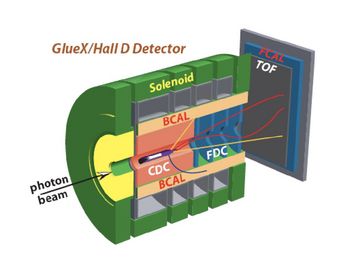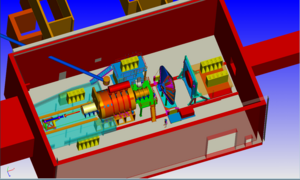GlueX Project Overviews
Contents
GlueX Project Summaries and Documentation
Introduction to the GlueX Experiment
The following are links to a series of videos on the GlueX experiment. They are meant to provide an introduction to the GlueX experiment for new members of the collaboration. In addition to the videos, the presentations form the video are provided. These are not meant to be complete, but rather a quick way to bring new collaboration members to a basic level of understanding of the experiment.
A Short History of GlueX
This presentation and video present a quick overview of the history of GlueX going from the first meeting in summer 1997 until the present. This is the first of a series of information presentations on the GlueX experiment.
The Photon Facility
This presentation and video present a quick overview of the Hall-D photon facility. It follows the photon beam from production on the diamond radiator through to the photon beam dump, providing a description of each of the detector and beam elements that are part of the process. This is the second of a series of information presentations on the GlueX experiment.
The GlueX Detector
This presentation and video present a quick overview of the GlueX detector in Hall D at Jefferson Lab. It starts with a detector overview, then describes the magnet, liquid hydrogen target and the detector systems in GlueX including the DIRC and the CCAL. It ends with a brief description of the GlueX physics trigger. This is the third of a series of information presentation on the GlueX experiment.
Introductory Lectures on GlueX Physics
Quarks and Mesons
Lecture 1: Fermion Anti-fermion Systems
The lecture discusses building up fermion anti-fermion systems looking at how the spin and orbital momentum combine to form total angular momentum J. It also discusses parity P and charge conjugation C.
Lecture 2: Quarks and Isospin
The lecture discusses isospin and how it is related to up and down quarks. It also builds up systems of 2 and 3 quarks through isospin, and then looks at the isospin of anti-up and anti down quarks, and how mesons are built up with isospin. Finally, isospin and C-parity and used to define G-parity.
Lecture 3: Young's Tableaux and SU(N)
The lecture discusses how to use Young's tableaux to compute products in SU(N). It then specializes to SU(3) and looks at how octets, nonets, decuplets and other representations are built up.
Lecture 4: Mesons in SU(3)
The lecture discusses the how flavour SU(3) from up, down and strange quarks can be used to define the quark content of mesons. Hypercharge is introduced as well as weight diagrams. Finally, mixing between the octet and singlet isospin zero states in a nonet is discussed, and ideal mixing is introduced.
Lecture 5: Strong Decays of Mesons
The lecture discusses how to use the conserved quantum numbers J, P, C, I and G to determine which meson decays are possible. It also discusses the case of identical mesons and how symmetry plays a role in determining allowed decays.
Lecture 6: SU(3) Clebsch-Gordan Coefficients and Meson Decays
The lecture introduces the SU(3) Clebsch-Gordan coefficients that can be used to determine relations between how mesons in a particular nonet decays to two mesons in other nonets. I looks at the four possible decays of octet and singlet states to pairs of mesons, and covers a rarely discussed detail on octets decaying to two octets.
Informational GlueX Notes
Meson Names
Prior to 1986, there was no clear convention for the names of mesons with authors suggesting names with initial observations. There were also mesons that had more than one name, and a number of confused states including the $E/\iota$ puzzle and the $\theta$ meson. In 1986, the Particle Data Group proposed a systematic naming scheme. This document describes that 1986 naming scheme, and provides a translation from the old names to the new ones. It also provides some historical information on the states.
Historical Information on the GlueX Experiment
|
During 2008, the Gluex Detector underwent a series of detailed reviews as part of the Lehman review process. From those reviews, a description of the detector was written that describes both the physics case and the anticipated detector performance: GlueX Project Description A pdf version of the figure is available. |
|
|
In late 2008, the beamline and tagger for HallD were reviewed. As part of that process, a detailed description of these elements was prepared. That description can be found here: Beamline Documentation | |
|
In July 2006, there was a detailed presentation on GlueX to PAC30. The material that was prepared for
the PAC is available here:
GlueX PAC 30 Documentation
|
|
 |
In fall of 2011, the GlueX collaboration working with Jefferson Lab put together a Hall-D poster. A thumbnail of the poster is shown to the write, while the 7MByte jpg file suitable for hi-resolution printing at 18" by 24" can be obtained from the GlueX document archive: Hires Poster. |

